36 Shrubs with Black Berries or Berry-Like Fruit
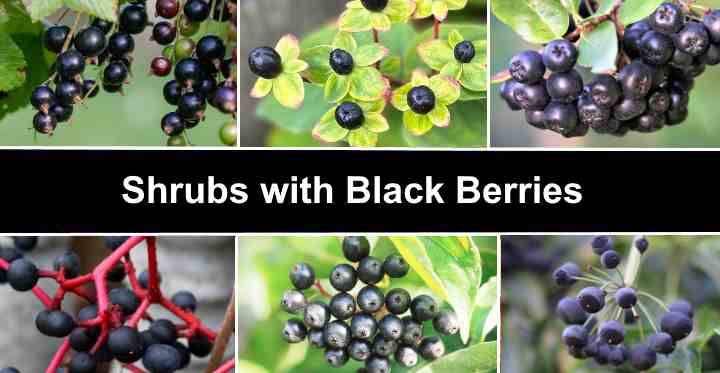
Growing shrubs with black berries is a great way to enhance your garden landscape. Shrubs with berry-like fruits add color, vibrancy, and textures to front or backyards. Additionally, some shrubs bearing black berries give you a tasty harvest when the fruit ripens in summer or fall. So what are the best shrubs with black berries for your landscape?
The most common berry-producing shrubs with edible black berries are blackberries, blackcurrants, grapes, and chokeberries. Additionally, many types of evergreen shrubs produce black fruits. For example, cherry laurel, holly, dogwood, and Oregon grape shrubs produce black berries and provide year-long greenery in your yard.
Choosing the right shrubs is crucial if you are a gardening enthusiast or simply want to add color to your outdoor space.
This article explores many shrubs with black berry-like fruits for your garden. From low-growing ornamental varieties to bushy plants with edible fruit, there are shrubs on this list suitable for your garden landscape.
Black Berry Identification
Identifying berries involves observing key features like shape, size, and arrangement. For example, black berries can be round or oval, small to medium, and grow in clusters or singly. Examining the shrub leaf shapes, patterns, and size can also help identify black fruit-producing shrubs. Some shrubs also have thorny branches.
Shrubs With Black Berries
Berries are fleshy fruits with seeds inside. Examples of true black berries include blackcurrants and black grapes. However, people refer to other small black fruits as berries, although they are not berries in the botanical sense. For example, sloes and black cherries are types of drupes, and black berries are aggregate fruits.
This article refers to all types of black fruit from shrubs as berries, whether in the botanical sense or not.
Why It’s Important to Identify Shrubs with Black Berries
Accurate berry identification is crucial for your health. Mistaking toxic berries for edible ones can lead to serious illness or even death. For example, black nightshade (Solanum nigrum) and deadly nightshade (Atropa belladonna) have similar fruits. However, the black, shiny, deadly nightshade berries are highly toxic. Therefore, never consume black berries without determining the species.
Types of Shrubs With Black Berries (With Pictures and Identification Guide)
Let’s look in detail at types of shrubs that produce black berry-like fruit.
Black Chokeberry (Aronia melanocarpa)
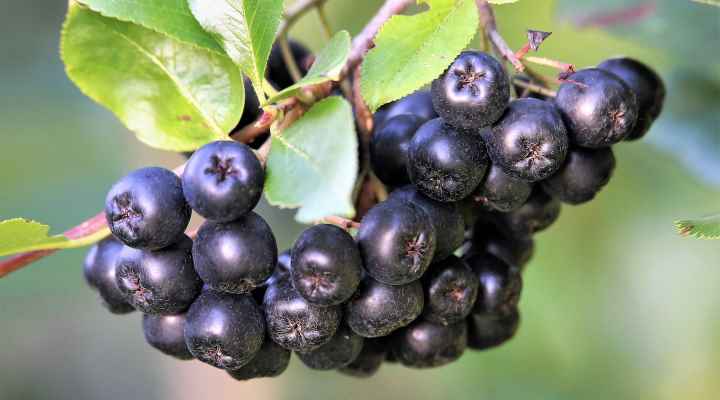
Black chokeberry is a small shrub producing clusters of small black berries. It’s a thorny shrub with showy clusters of round, jet-black berries, each measuring 0.4” (10 mm) in diameter. The shrub also features glossy, bright green leaves and clusters of whitish-pink fragrant flowers. The dark purple to black berries ripen in the fall.

Black chokeberry flowers
Black chokeberry shrubs grow up to 6 ft. (1.8 m) tall and wide. The nectar-rich white flowers bloom throughout summer, attracting pollinators to garden landscapes. The attractive foliage turns brilliant red shades in the fall, and its clusters of glossy black berries add winter interest and attract songbirds and small mammals.
Black chokeberries have a distinctive sharp, sour taste that is bitter and astringent. The berries are typically used to make jellies and jams. However, they are typically too sour to eat straight from the shrub. The shrubs thrive in boggy to dry sandy soils and are drought-tolerant.
- USDA Planting Zones: 3 to 8
- Sunlight: Full sun to partial shade
- Mature Size: 3 to 6 ft. (0.9 – 1.8 m) tall and wide
Chokecherry (Prunus virginiana)
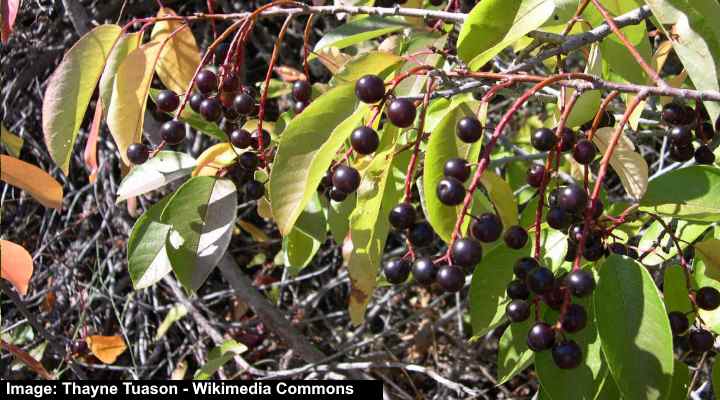
Chokecherry is a large shrub that has an abundance of pea-sized purple-black berries in late summer. The identifying features of the thorny shrub are its elliptic, finely serrated leaves, masses of cup-shaped flowers in cylindrical clusters, and small, round, dark berries. In the fall, the shrub-like tree has golden-yellow to orange foliage.
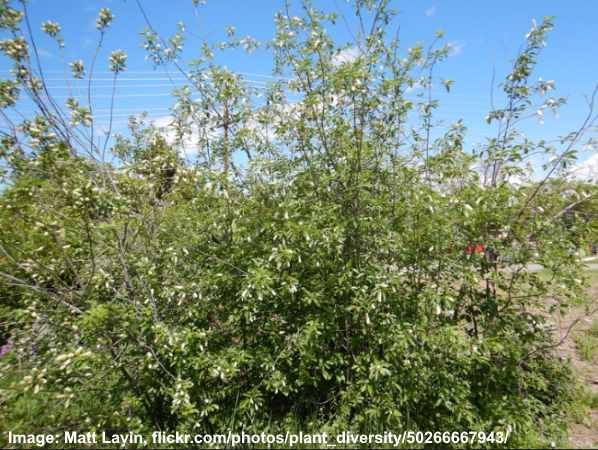
A chokecherry shrub
This thornless large shrub or small tree grows up to 30 ft. (9 m) tall. Its elongated flower clusters measure 6” (15 cm) long and bloom in spring. Chokecherry shrubs are versatile plants, able to thrive in a variety of soil types. The dark purple-black berries create color in landscapes in late summer through winter.
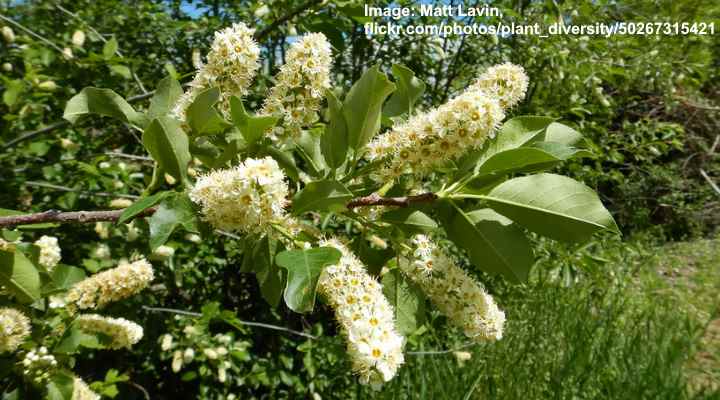
Chokecherry flowers
The black berries of the chokecherry are edible and have a bitter, astringent taste. They emerge red and ripen to deep purple, almost black. Despite their astringency, the black berries are used for making jellies, syrups, and wines.
- USDA Planting Zones: 2 to 7
- Sunlight: Full sun to partial shade
- Mature Size: 20 to 30 ft. (6 – 9 m) tall and up to 20 ft. (6 m) wide
Blackcurrant (Ribes nigrum)
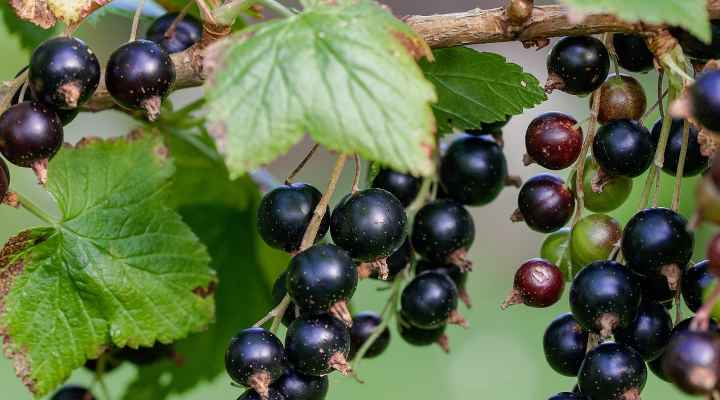
Blackcurrant is a deciduous shrub producing clusters of dark purple or black berries. This shrub features clusters of yellow flowers in spring and dark green leaves with three lobes and serrated edges. The tasty black berries are round and measure 0.4” to 0.6” (10 – 15 mm) in diameter.
The small, round black berries or currants ripen in early to mid-summer. They have a fruity, earthy, tart flavor due to the high tannin content in the skin. Blackcurrant flesh is reminiscent of raspberries or grapes. The black berries are popular for culinary uses such as jams, jellies, and desserts.
Blackcurrant shrubs typically reach a height of up to 5 ft. (1.5 m) and have a spreading habit. The round, black berries grow in dangling clusters called strigs. According to research, blackcurrants are high in vitamin C and antioxidants and have numerous health benefits.
- USDA Planting Zones: 3 to 7
- Sunlight: Full sun or partial shade
- Mature Size: 4 to 5 ft. (1.2 – 1.5 m) tall and wide
Black Gooseberry (Ribes lacustre)
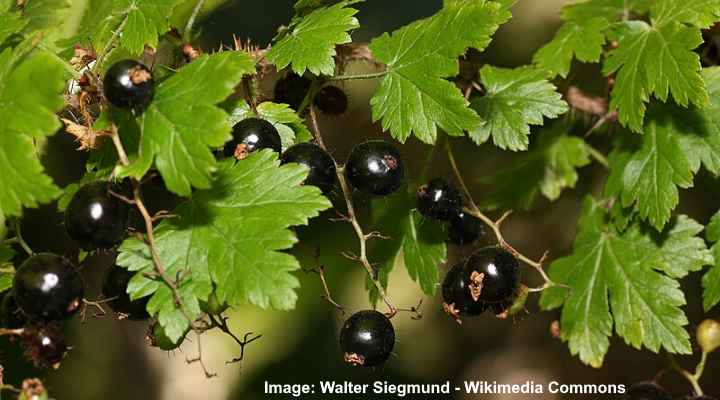
Black gooseberry—also called prickly currant—is a deciduous shrub with shiny dark purple to black berries. This thorny shrub has small green leaves with five to seven lobes and reddish or maroon flowers that bloom in spring. The fruiting shrub grows up to 6.5 ft. (2 m) tall. Its black fruits are 0.31” (8 mm) long.
Black gooseberry is a hardy shrub with berry-like black fruits that thrives in moist, well-drained soil. Due to its tolerance of soggy soil, it’s also called black swamp gooseberry. You can commonly find the shrub in the wild, growing in wetlands, stream banks, rocky slopes, and forest edges.
You can plant black gooseberry as a border plant or ornamental shrub in landscaping. It also naturalizes areas, and its dense growth is ideal for erosion control. The black berries attract wildlife and are delicious in jams or desserts.
- USDA Planting Zones: 2 to 7
- Sunlight: Partial shade to full sun
- Mature Size: 3 to 6.5 ft. (0.9 – 2 m) tall and wide
Blackberry (Rubus fruticosus)

Blackberry is a scrambling shrub with prickly stems and black fruits resembling raspberries. The deciduous shrub blooms in late spring with white, five-petalled flowers, which develop into drupelets forming a juicy black fruit. It also has leaves featuring five lanceolate leaflets. Blackberry shrubs grow 20 ft. (6 m) tall.
Blackberry shrubs require full sunlight and moist, well-draining soil to produce abundant fruit. They are also drought-tolerant and can tolerate a wide range of soil conditions. The shrubs perform well as hedgerows, foundation planting, windbreaks, or border shrubs. Its thorny canes act as an effective security barrier.
- USDA Planting Zones: 5 to 9
- Sunlight: Full sun
- Mature Size: 10 to 20 ft. (3 – 6 m) tall, depending on the variety
Marionberry (Rubus ’Marion’)
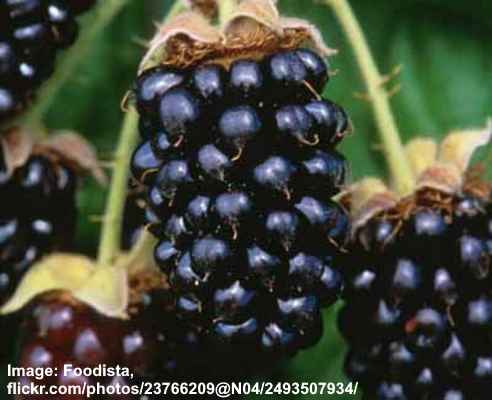
Marionberry is a deciduous shrubby vine with large black raspberry-like fruit growing on spiny stems. The black berries—like raspberries and blackberries—consist of juicy drupelets creating an oval fruit. The lobed, heart-shaped green leaves, white cup-shaped flowers, and black berries grow on thorny canes 20 ft. (6 m) tall.
Marionberries are known for their excellent flavor. Like black berries or brambles, the berries have a sharp, tart, earthy flavor with hints of sweetness. The berries ripen to black and are ready for picking in mid to late summer.
The black fruits are ideal for eating fresh or used in culinary creations like jams, jellies, pies, and desserts. Like all black berries and berry-like fruits, they are a good source of vitamins, minerals, and antioxidants.
- USDA Planting Zone: 6 to 9
- Sunlight: Full sun to partial shade
- Mature Size: Up to 20 ft. (6 m) long
Black Raspberry (Rubus occidentalis)
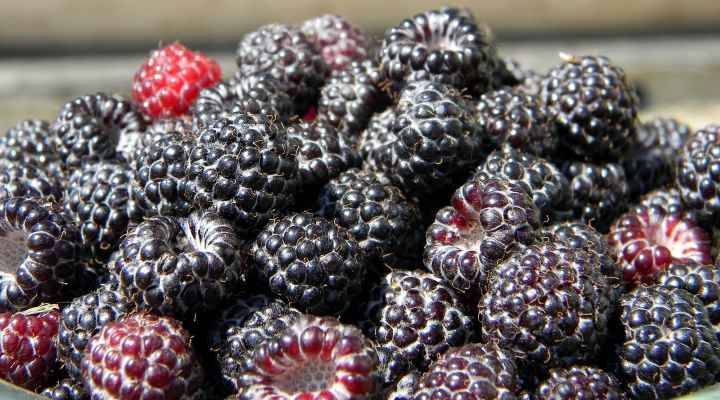
Black raspberries are sweet fruits that grow on thorny shrubs. The delicious, black-colored berries are round and flavorful. The features of black raspberry shrubs are their cluster of rose-like white flowers, bluish-green compound leaves, and yellow fall colors. The fruiting shrub grows up to 6 ft. (1.8 m) tall.
Black raspberry shrubs feature erect or arching canes. The round, edible berries are red before maturing to black. Compared to red raspberries, the black variety has a sweeter, less tart taste. You can eat the sweet, juicy fruits fresh from the shrub or use them to make jams, jellies, or baked goods.
Black raspberry shrubs thrive in full sun and well-drained soil. Partial shade tends to impact fruit yield, resulting in fewer berries. Also, regular pruning is necessary to remove old canes that spread easily.
- USDA Planting Zones: 4 to 8
- Sunlight: Full sun or partial shade
- Mature Size: 3 to 6 ft. (0.9 – 1.8 m) tall and 4 to 8 ft. (1.2 – 2.4 m) wide
Black Huckleberry (Gaylussacia baccata)
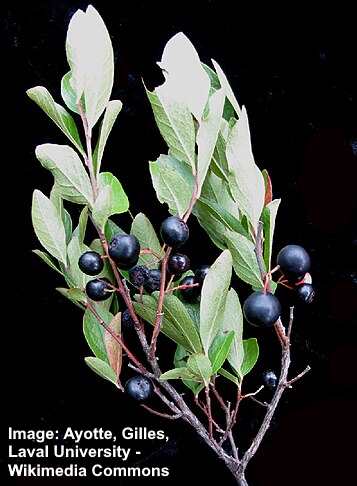
Black huckleberry is a low-growing deciduous shrub that produces purplish-black berries. The edible blackish-blue berries are round and measure 0.33” (8.5 mm) in diameter. The shrub’s other identifying features are its pink or red urn-shaped flowers in dangling clusters and oblong, glossy green leaves. In fall, the shrub turns golden yellow shades.
This low-growing ornamental fruit shrub doesn’t grow taller than 3 feet (0.9 m). The small, bell-shaped, colorful flowers bloom in late spring to early summer. Once pollinated, they give way to clusters of round dark berries that ripen in late summer to early fall. Huckleberries have a spicy, sweet taste and are refreshing snacks.
In addition to producing edible black berries, the black huckleberry is an attractive ornamental garden shrub. It performs well as a foundation planting, shrub border, or informal hedge. Its narrow oval leaves turn orange, red, or burgundy in the fall. Its flowers and fruits attract pollinators and birds.
- USDA Planting Zones: 4 to 7
- Sunlight: Full sun to partial shade
- Mature Size: 1 to 3 feet (0.3 to 0.9 m) tall and 5 ft. (1.5 m) wide
Evergreen Huckleberry (Vaccinium ovatum)
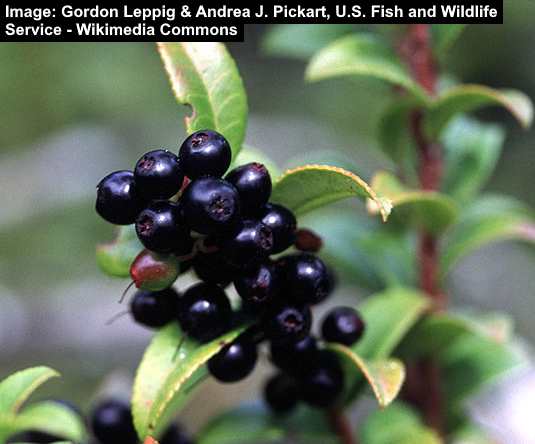
Evergreen huckleberry—also called California huckleberry—is a small evergreen shrub with clusters of edible black berries. The berries are ready for picking in late summer. Other features of the shrub are its glossy, dark green leathery leaves, small white or pink bell-shaped flowers, and evergreen foliage. The shrub grows up to 8 ft. (2.4 m) tall.
Native to the Pacific coastal area of North America, evergreen huckleberries are popular ornamental fruit shrubs. You can grow the shrub in full sun or part shade to enjoy its edible black fruits, or you can use it as a foundation planting or a hedge. It also tolerates full shade but at the expense of flowers and fruit.
- USDA Planting Zones: 7 to 9
- Sunlight: Full sun, partial shade, or deep shade (however, no flowering or fruits appear in shaded conditions)
- Mature Size: 2 to 8 ft. (0.6 – 2.4 m) tall and 3 to 10 ft. (0.9 – 3 m) wide
Black Crowberry (Empetrum nigrum)
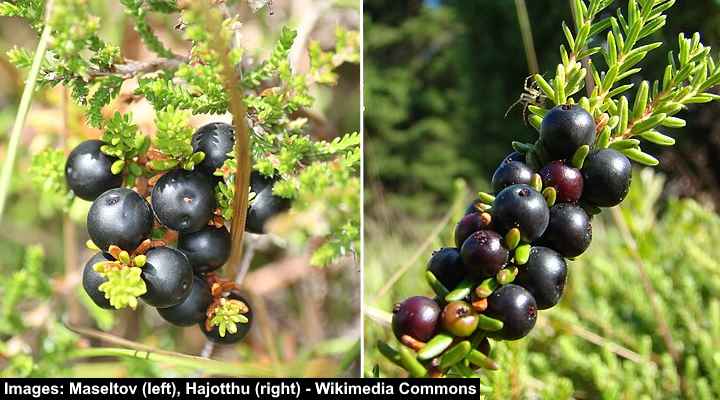
Black crowberry is a low-growing evergreen shrub producing black, berry-like fruits. This shrub features tiny, needle-like leaves that are 0.25” (6 mm) long, round, shiny black drupes, and insignificant flowers. The black round fruits measure 0.2” (5 mm) in diameter. Black crowberry shrubs don’t grow taller than 1 ft. (0.3 m) tall.
Black crowberry is a hardy shrub suitable for growing in harsh climates. It tolerates cold, salt air, and drought, making it ideal for planting in coastal areas. Ornamental uses of black crowberry include evergreen ground cover, foundation planting, rock gardens, and preventing soil erosion.
Black crowberry purplish-black berry-like drupes taste bitter, slightly acidic, and astringent. The edible fruits are sweetened for jams, jellies, liqueurs, wines, and desserts.
- USDA Planting Zones: 3 to 8
- Sunlight: Full sun to partial shade
- Mature Size: Up to 12” (30 cm) tall and spreads 18” (45 cm) wide
European Dewberry (Rubus caesius)
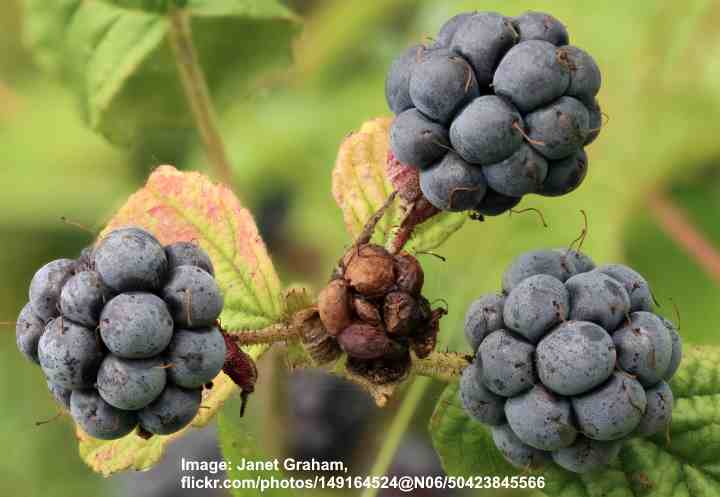
Dewberry is a small deciduous shrub with prickly stems and delicious black berry-like drupes. This black-fruiting shrub features three-lobed green leaves and clusters of showy white flowers 1” (25 mm) in diameter. Its fruit is juicy black drupes resembling small, black raspberries that ripen in late summer to early fall. The black berries measure 0.4” (10 mm) in diameter.
Black dewberries sometimes appear dark blue due to the waxy substance on the berries. The small black fruits have a slightly sweet but distinctly tart flavor—perfect for eating fresh or making jams, jellies, and desserts.
Dewberry shrubs grow up to 7 ft. (2.1 m) tall. Its stems are covered in sharp spines and grow densely to form thickets. The shrub’s thorny stems are ideal for a natural fence, foundation planting, or security barrier. It also has a climbing nature, allowing it to scramble over pergolas or arbors.
- USDA Planting Zone: 4 to 8
- Sunlight: Full sun to partial shade
- Mature Size: Trailing stems 1.5 to 7 ft. (0.45 – 2.1 m) long
Black Grapes (Vitis)
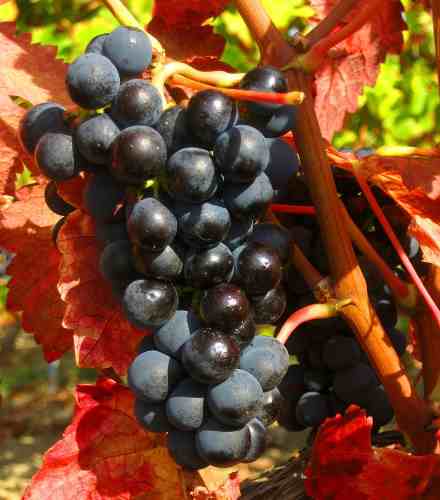
Technically falling under the category of vines rather than shrubs, grapes are nonetheless a significant addition to the landscape, offering both aesthetic beauty and culinary value.
Black grapes are berries in the true botanical sense, comprising small, oval, juicy fruits that grow in bunches on shrubby vines. While green and purple grapes are more commonly known, some grape varieties are deep purple to almost black colors. Additionally, dried purple grapes transform into black raisins, further diversifying their use.
Black Spanish grape (Vitis’ Black Spanish’)
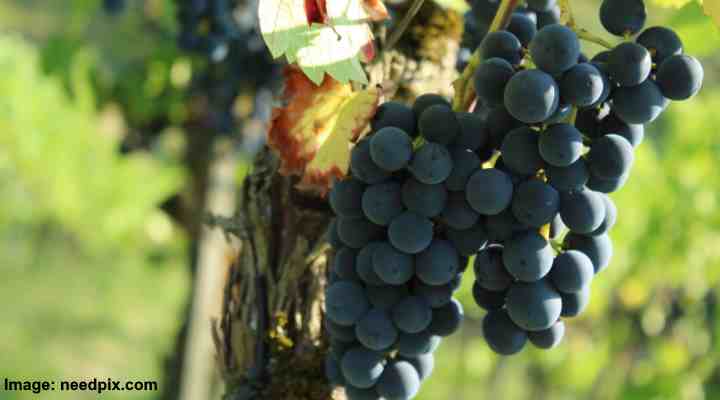
Black Spanish grapes grow in large clusters on deciduous shrubs. The vigorous shrubs produce dark purple-black grapes known for their firm, sweet flesh, and juicy texture. The climbing shrub also has medium to dark green, palmately lobed leaves with serrated margins. It grows up to 8 ft. (2.4 m) tall.
Black Spanish grape shrubs are popular for winemaking due to their excellent disease resistance and juicy berries. Additionally, the twining shrub scrambles over fences, trellises, and arbors, creating vertical accents in warm climates. It thrives in full sun and produces exceptionally large bunches of grapes in summer.
- USDA Planting Zone: 7 to 10
- Sunlight: Full sun
- Mature Size: 6 to 8 ft. (1.8 – 2.4 m) tall
Grape Vine Black Hamburg (Vitis vinifera ‘Schiava Grossa’)
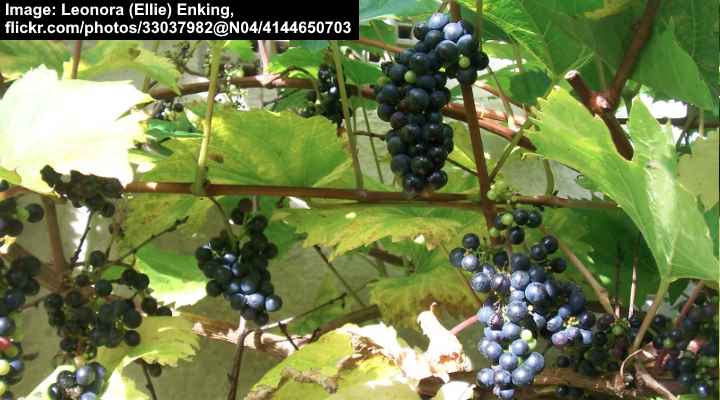
Black Hamburg grapes are round, dark red to dark purple, almost black berries. The bunches of black grapes grow on deciduous shrub-like vines. Its wood stems have palmately lobed leaves in a rich green color. The leaves turn shades of red or yellow in the fall. It’s an easy greenhouse grape vine to grow.
‘Black Hamburg’ is a versatile, frost-hardy variety of grape. It thrives in sunny locations when protected from cold winds. Its vining nature means the stems can climb sturdy structures like trellises or pergolas. In addition to producing wine, the large, round black grapes are tasty snacks straight off the plant.
- Sunlight: Full sun
- Mature Size: Climbs 26 to 40 ft. (8 to 12 m) in height
Cherry Laurel (Prunus laurocerasus)
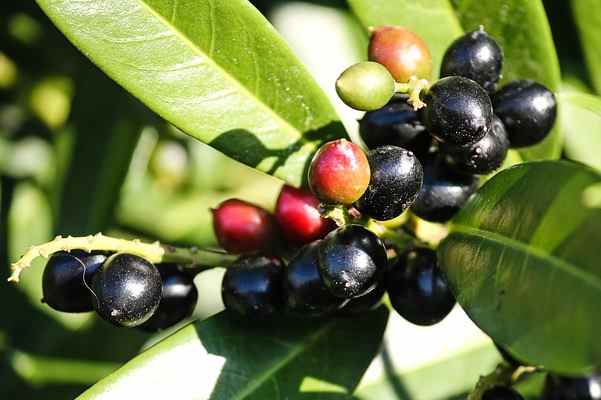
Cherry laurel is an evergreen shrub known for its cherry-like purple-black fruits. The vigorous shrub is characterized by its glossy, dark green leathery leaves 6” (15 cm) long and fragrant, creamy-white flowers in upright cylindrical clusters. The large shrub or small tree grows up to 30 ft. (9 m) tall and wide.
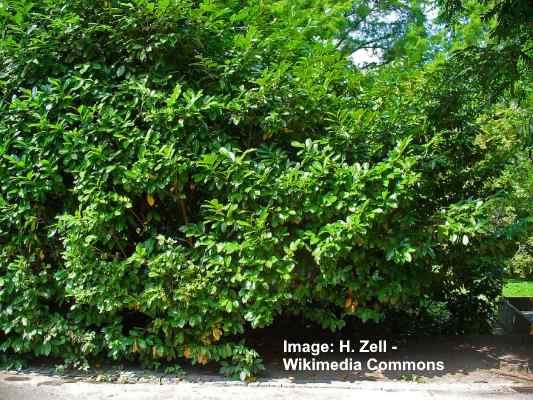
A cherry laurel shrub
Versatile cherry laurel shrubs are ideal as an evergreen hedge, privacy screen, or standalone specimen in the landscape. Its fragrant white flowers add color to spring landscapes and attract pollinators. Also, its evergreen foliage contrasting with clusters of red or black fruits adds winter interest.
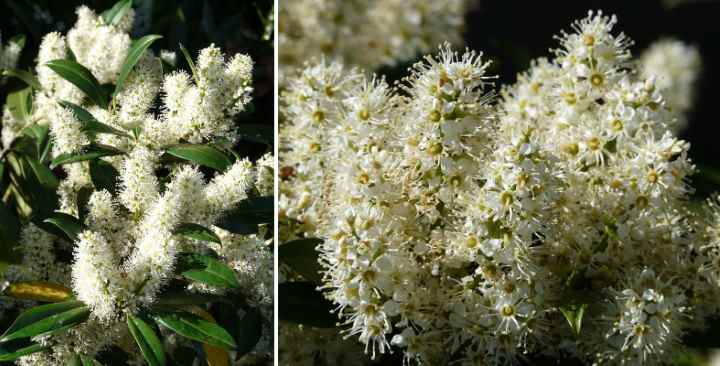
Cherry laurel flowers
It’s important to note that all parts of the shrub—stems, branches, flowers, and fruits—are toxic to humans and pets. Cherry laurel is one of the few evergreen, white-flowering shrubs that thrive in full shade.
- USDA Planting Zones: 6 to 9
- Sunlight: Full sun, partial shade, heavy shade
- Mature Size: 15 to 30 ft. (4.5 – 9 m) tall and wide
Carolina Cherry Laurel (Prunus caroliniana)

Carolina cherry laurel is an evergreen shrub with reddish-purple fruits that ripen to shiny black. It’s a fast-growing shrub with a pyramidal-oval habit, clusters of tiny white flowers, and glossy, dark green leaves. The dense flowering racemes are 3” (7.5 cm) long, and the leaves are 2” to 4” (5 – 10 cm) long.
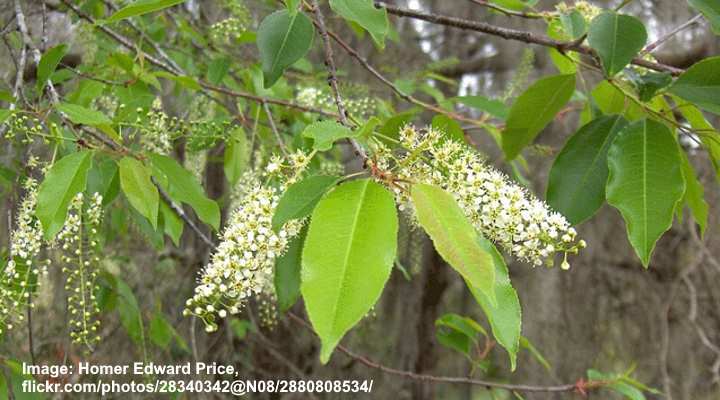
Carolina cherry laurel flowers and leaves
Native to North America, Carolina cherry laurel shrubs grow up to 90 ft. (9 m) tall. The easy-grow, black-fruiting shrub is ideal as a privacy screen, evergreen hedge, or shrub border. An attractive feature of the shrub is the masses of sweetly fragrant flowers that adorn spring landscapes.
This shrub is a great choice for creating privacy in your yard, as it has a dense growth habit. It can be pruned to maintain a desired shape or size. Carolina cherry laurel is also popular for coastal gardens, as it can tolerate salt spray.
- USDA Planting Zones: 7 to 10
- Sunlight: Full sun to partial shade
- Mature Size: 20 to 30 ft. (6 – 9 m) tall and 15 to 25 ft. (4.5 – 7.6 m) wide
Spiked Blackthorn (Prunus spinosa)
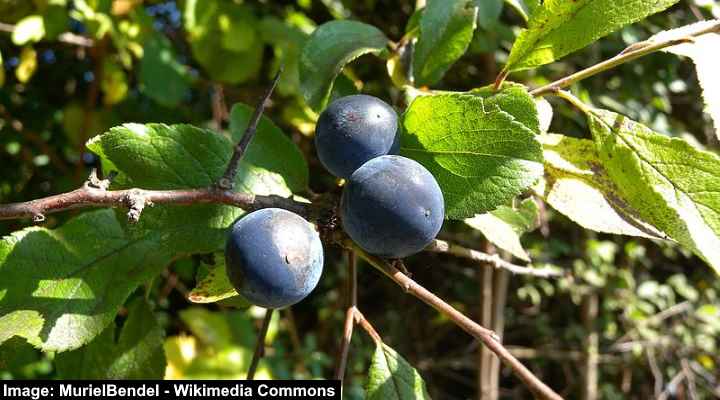
Also called sloe, spiked blackthorn shrubs produce black berries with a purple-blue waxy covering. It’s a deciduous shrub growing 16 ft. (5 m) tall with creamy-white flowers, oval leaves, and purplish-black round fruits. This prickly shrub blooms in spring, and its small, blue-black fruits ripen in late summer or early fall.
Sloe berries are popular for making jams and jellies and flavoring gin. As a type of wild plum, the small berry-like stone fruits have a sour, tart taste straight off the shrub. The clusters of dark berries are ideal for wildlife gardens to attract birds. In garden landscapes, spiked blackthorn is popular as a hedge plant.
- USDA Planting Zones: 4 to 8
- Sunlight: Full sun to partial shade
- Mature Size: 10 to 16 ft. (3 to 5 m) tall and wide.
Holly Shrubs (Ilex)
Several varieties of holly shrubs produce dark or black berries, adding visual interest to fall and winter landscapes. These attractive evergreen shrubs don’t have the vibrant red berries characteristic of many holly tree and shrub varieties.
Japanese Holly (Ilex crenata)
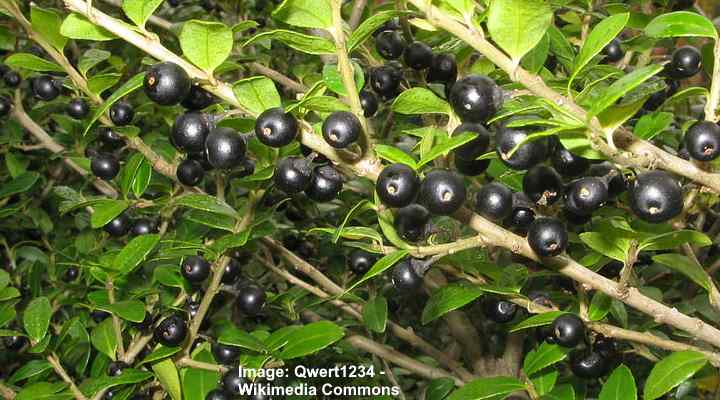
Japanese holly is a versatile evergreen shrub producing small black berry-like fruits. The identifying features of the evergreen shrub are its wavy, leathery leaves with spiny edges, tiny white flowers in spring, and black fruits in summer and fall. It’s a slow-growing shrub growing up to 10 feet (3 m) tall.
Japanese holly shrubs are ideal landscaping choices for hedges, borders, or foundation planting. It’s adaptable to various soil types and tolerates drought once established.
- USDA Planting Zones: 5 to 7
- Sunlight: Full sun to partial shade
- Mature Size: 4 to 10 ft. (1.2 to 3 m) tall and wide
Inkberry (Ilex glabra)
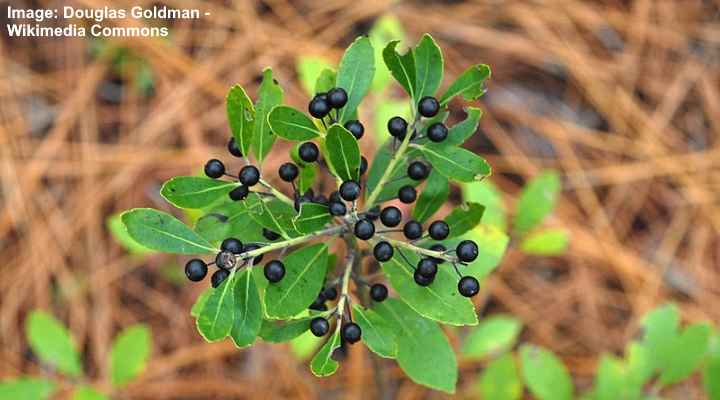
Inkberry is a multi-stemmed evergreen shrub featuring edible black berry-like drupes. This compact shrub has glossy, dark green, ovate leaves, and flat-topped clusters (cymes) of fragrant, whitish flowers. Inkberry shrubs grow up to 10 ft. (3 m) tall, and its small black berries persist on the shrub throughout the winter.
The dense foliage and compact habit make inkberry popular for hedges or foundation plantings. Its fragrant flowers and soft-fleshed berries also make the shrub ideal for providing food and habitat for wildlife.
- USDA Planting Zones: 4 to 11
- Sunlight: Full sun to partial shade
- Mature Size: 5 to 10 ft. (1.5 to 3 m) tall
Tall Inkberry Holly (Ilex coriacea)
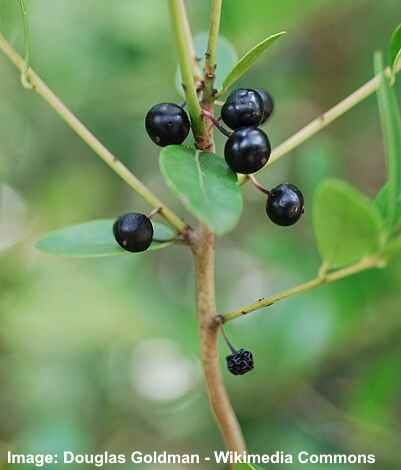
Tall inkberry holly—also called baygall bush—is a large evergreen shrub producing shiny black round berries. Tall inkberry holly shrubs grow up to 20 ft. (6 m) tall. The shrub’s identifying features are its open crown, prickly, leathery, elliptical leaves, and small, greenish-white flowers. The small black berries persist through the winter, providing food for wildlife.
Landscaping uses for tall inkberry holly shrubs are as a hedge, screen, or as an accent plant. Its fragrant flowers make it ideal for butterfly gardens.
- USDA Planting Zones: 6 to 9
- Sunlight: Full sun to partial shade
- Mature Size: 15 to 20 ft. (4.5 to 6 m) tall
Saskatoon Serviceberry (Amelanchier alnifolia)
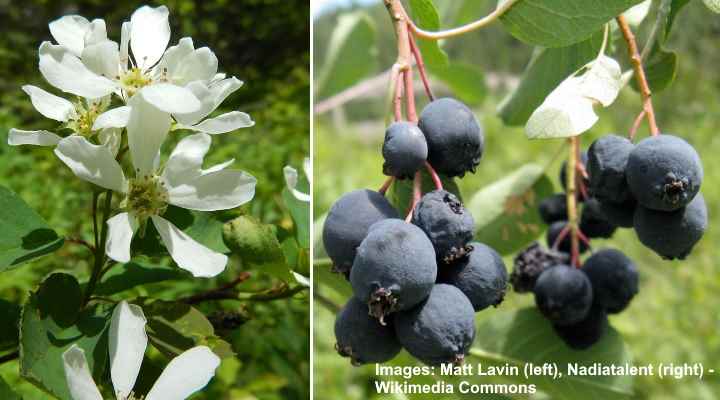
Saskatoon serviceberry flowers and fruit
Saskatoon serviceberry is a deciduous shrub that produces edible blue-purple, almost black berries. This shrub blooms in spring with clusters of fragrant white blossoms. It features coarsely-toothed light green leaves with brilliant red and orange shades in the fall. This serviceberry shrub has an upright, spreading growth habit.
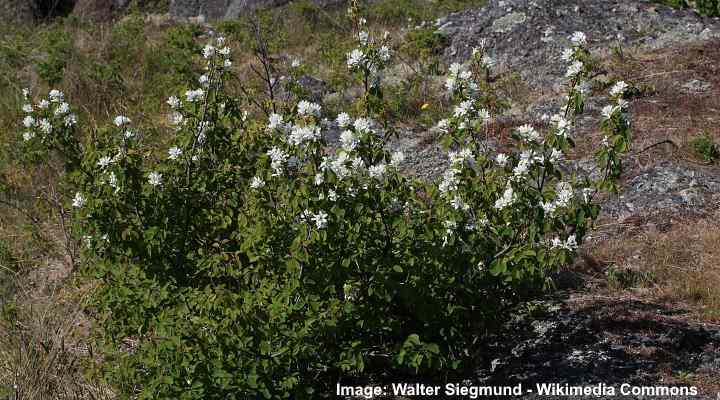
A Saskatoon serviceberry shrub
Saskatoon serviceberry shrubs have multi-season interest. In the spring, it produces clusters of delicate white flowers. It has attractive foliage and small, round berries in summer and fall. In winter, its attractive gray bark with charcoal-gray liner marks is on show after the leaves drop.
- USDA Planting Zone: 2 to 7
- Sunlight: Full sun to partial shade
- Mature Size: 10 to 15 ft. (3 to 4.5 m) tall and wide
Common Dogwood (Cornus sanguinea)
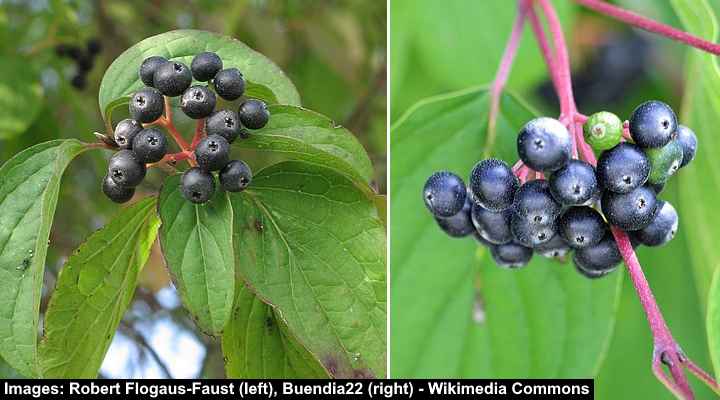
Also called bloodtwig dogwood, common dogwood is a deciduous, suckering shrub with purplish-black berry-like drupes. The outstanding shrubby plant features colorful red stems in winter, ovate-shaped dark green leaves that turn purple or burgundy in the fall, and small white flowers blooming in flat-topped clusters. The ornamental shrubs grow up to 10 ft. (3 m) tall.
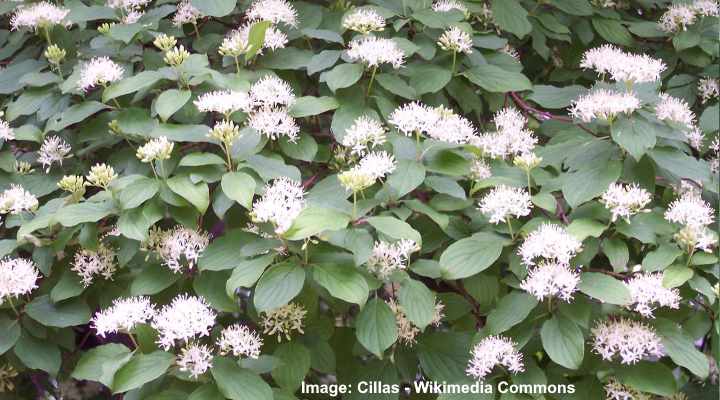
Common dogwood flowers and leaves
Common dogwood shrubs are great for planting borders, hedges, or mass plantings. In addition to its ornamental value, common dogwood has value for wildlife. The nectar-rich flowers and black berries provide food for hummingbirds, pollinators, and songbirds.

Red twig dogwood shrubs add beautiful color to your garden in winter. In the picture: Cornus sanguinea ‘Anny’s Winter Orange’
- USDA Planting Zones: 5 to 7
- Sunlight: Full sun to partial shade
- Mature Size: 6 to 10 ft. (1.8 to 3 m) tall and wide
Japanese Aralia (Fatsia japonica)
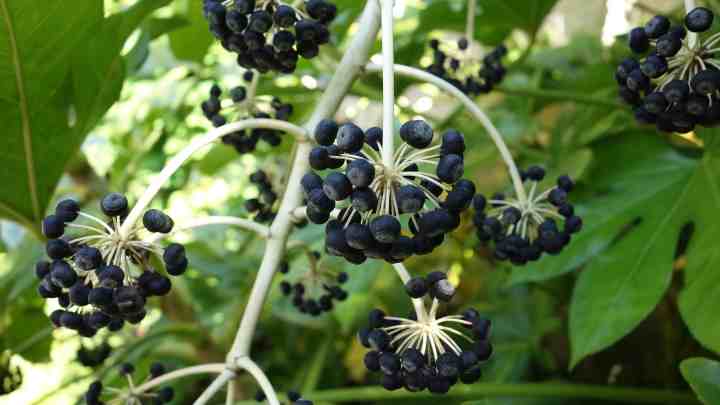
Japanese aralia produces showy black berry-like round fruits. This evergreen shrub has exotic evergreen palmate leaves with seven to nine lobes and umbels of creamy-white flowers, ideal for subtropical or tropical yards. Not growing taller than 20 feet (6 m), the shade-tolerant shrub adds visual interest to shaded gardens.
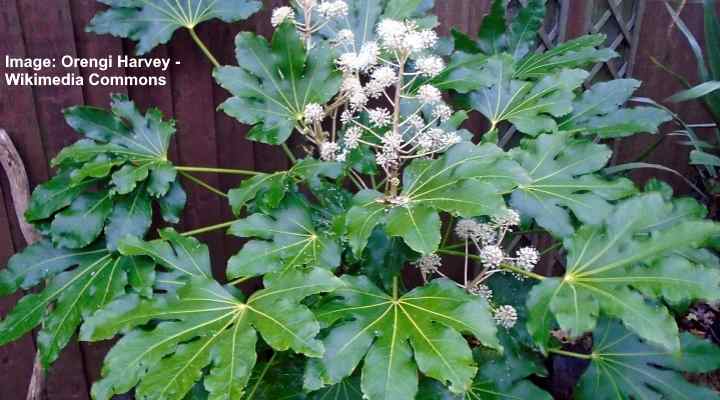
Japanese aralia flowers and leaves
Japanese aralia is a versatile shrub that thrives in various soils. It tolerates heavy shade, drought, pollution, and salt spray. Its large, spreading canopy makes it an ideal shrub for providing shade on a patio or decking area. It also grows well in containers and is a popular houseplant in temperate climates.
- USDA Planting Zone: 7 to 11
- Sunlight: Partial shade to deep shade
- Mature Size: 6 to 20 feet (1.8 – 6 meters) tall and up to 6 ft. (1.8 m) wide
Virginia Creeper (Parthenocissus quinquefolia)
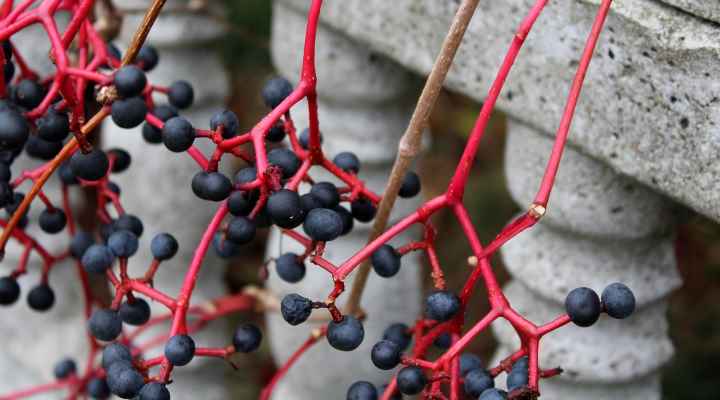
Virginia creeper is a fast-growing vine known for its blue-black berries and vibrant red fall foliage. Attractive features of this deciduous vine are its five-lobed green leaves, small greenish summer flowers, and dark blue-black berries that attract birds. The climbing plant’s attractive foliage emerges bronze or purple, turns green, and changes to brilliant red and crimson shades in the fall.

Virginia creeper vines quickly cover unsightly walls and fences with their fast growth rate
Virginia creeper vines can climb walls, fences, or trellises with the help of small adhesive discs at the end of their tendrils. It grows up to 50 ft. (15 m) tall. The versatile plant is ideal for use as ground cover, a climbing vine, or erosion control. Its shade tolerance makes it suitable for shady areas.
- USDA Planting Zones: 3 to 11
- Sunlight: Full sun, partial shade, deep shade
- Mature Size: 30 to 50 ft. (9 – 15 m) tall with a spread of 5 to 10 ft. (1.5 – 3 m)
Common Ivy (Hedera helix)
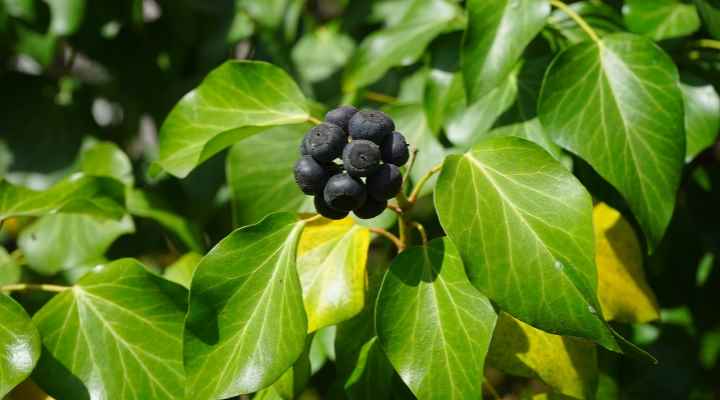
Common ivy is a versatile and hardy evergreen climbing vine producing black berries even when growing in the shade. This vigorous shade-loving evergreen plant has dark green, lobed or unlobed leaves growing on climbing vines. It blooms in the fall with clusters of greenish-white flowers. Common ivy grows up to 30 ft. (9 m) tall.
Common ivy clings to surfaces using aerial rootlets. This growth habit makes it an excellent choice for covering walls, trellises, or fences. It also tolerates a wide range of soil conditions, from poor to fertile, as well as sun and shade.
- USDA Planting Zones: 5 to 11
- Sunlight: Partial sun to full shade
- Mature Size: 20 to 30 ft. (6 – 9 m) tall and up to 15 ft. (4.5 m) wide
Shrubby St. John’s wort / Tutsan Berries (Hypericum androsaemum)
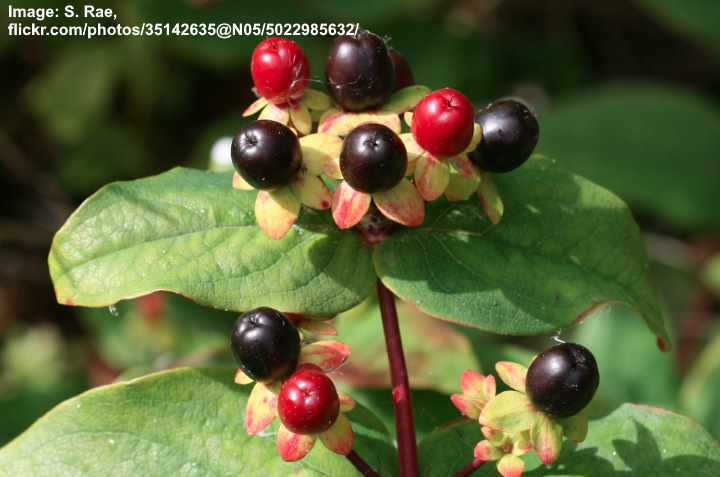
Also called sweet amber, shrubby St. John’s wort is a compact, easy-to-grow shrub with black berry-like fruits. An outstanding feature of this attractive shrub is its bright yellow cup-shaped flowers with five oval petals and protruding stamens. After flowering, clusters of vibrant red berries emerge that ripen to black in late summer.
Shrubby St. John’s word is a small ornamental shrub not growing taller than 3 ft (0.9 m). It’s drought-tolerant and grows well in partial shade. You can grow the shrubby plant to add a splash of color to beds, borders, and foundation lines.
- USDA Planting Zones: 5 to 8
- Sunlight: Full sun to partial shade
- Mature Size: 2 to 3 ft. (0.6 – 0.9) tall and wide
Privet Shrubs (Ligustrum)
Privet shrubs are evergreen or deciduous plants with dense foliage, often used for hedges. They feature small, oval leaves and produce clusters of white, fragrant flowers. Several privet shrub varieties produce small black berries.
Common Privet (Ligustrum vulgare)
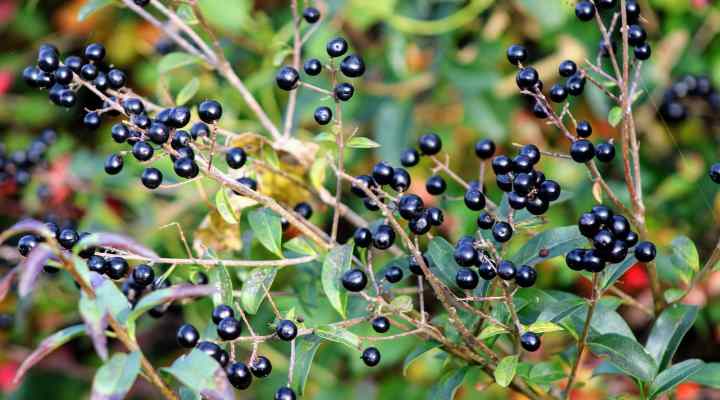
Common privet is a fast-growing shrub producing shiny black berry-like fruits in the fall. This bushy plant blooms in early summer with clusters of small white flowers. These contrast nicely with dark green, lance-shaped leaves. The shrub is ideal for garden hedging as it’s drought and pollution-tolerant.
Common privet grows up to 15 ft. (4.5 m) and thrives in part shade or full sun. Landscaping uses for the bushy shrub are as a hedge, border plant, or ornamental shrub. In warmer climates, it has semi-evergreen foliage.
- USDA Planting Zones: 5 to 8
- Sunlight: Full sun to partial shade
- Mature Size: 10 to 15 ft. (3 – 4.5 m) tall and 8 to 15 ft. (2.4 – 4.5 m) wide
Wax-Leaved Privet (Ligustrum lucidum)
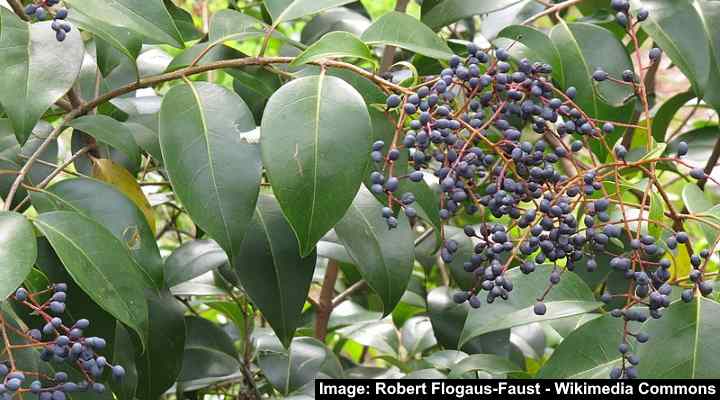
Wax-leaved privet is a large evergreen shrub with small black berry-like drupes that persist on the plant through fall and winter. This fast-growing shrub has upright branches, dense foliage, and clusters of small, white, tubular flowers. Popular for hedging, the shrub grows up to 50 ft. (15 m) tall.
Wax-leaved privet ornamental value from its white flower clusters, lush foliage, and black berries make it popular for landscaping. It tolerates full sun and partial shade and thrives in various soil conditions. It’s good to note that the flowers emit an unpleasant fragrance.
- USDA Planting Zone: 7 to 10
- Sunlight: Full sun to partial shade
- Mature Size: 15 to 50 ft. (4.5 to 15 m) tall and 8 to 15 ft. (2.4 – 4.5 m) wide
Japanese Privet (Ligustrum japonicum)
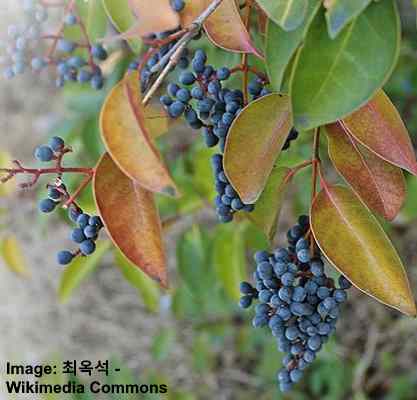
Japanese privet has attractive large clusters of purple-black round berries. It’s a fast-growing evergreen shrub with dark green, oval leaves, and clusters of creamy-white flowers blooming in late spring. Growing up to 12 ft. (3.6 m), the hedging plant is ideal as a privacy screen, security barrier, or foundation planting.
- USDA Planting Zones: 7 to 10
- Sunlight: Full sun to partial shade
- Mature Size: 6 to 12 ft. (1.8 to 3.6 m) tall and 6 to 8 ft. (1.8 to 2.4 m) wide
Viburnum Shrubs
Viburnum shrubs are versatile deciduous or evergreen plants prized for their clusters of fragrant flowers, vibrant berries, and attractive foliage. Many viburnum varieties produce small berry-like fruits in dark blue, purple, reddish-black, and jet-black colors.
Blackhaw Viburnum (Viburnum prunifolium)
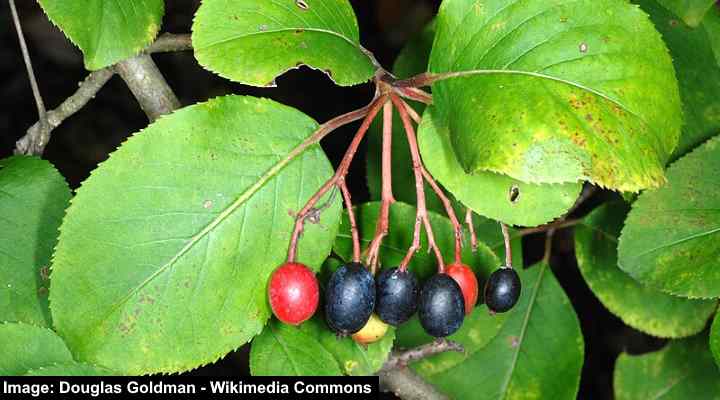
Blackhaw viburnum is known for its beautiful white flowers and dark blue-black berries. This deciduous shrub features oval-shaped leaves, flat-topped clusters of creamy-white flowers, and edible rose-red berries that mature to bluish-black. The multi-stemmed shrub grows up to 12 ft. (3.6 m) tall, adding height and structure to garden landscapes.

Blackhaw viburnum shrub, flowers and leaves
Blackhaw viburnum is a hardy shrub that tolerates various soil conditions. These include clay, loam, compacted soils, and dry soils. It’s also tolerant to drought, heat, and pollution.
- USDA Planting Zone: 3 to 9
- Sunlight: Full sun to partial shade
- Mature Size: 12 to 15 ft. (4.5 m) tall and up to 12 ft. (3.6 m) wide
Mapleleaf Viburnum (Viburnum acerifolium)
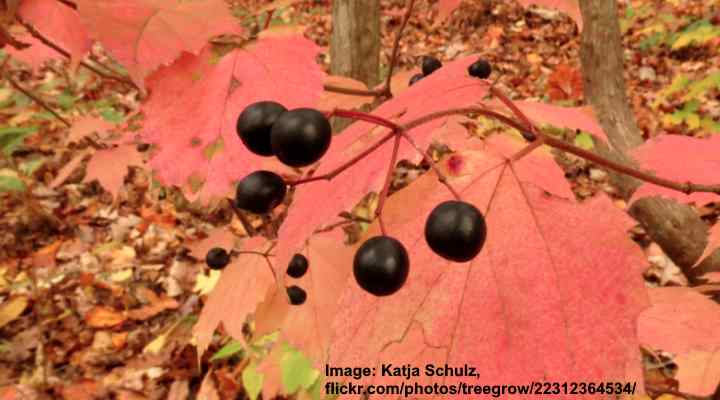
Mapleleaf viburnum is identified by its three-lobed maple-like leaves, flattened clusters of tiny white flowers, and shiny blue-black berries. This densely branched deciduous shrub’s foliage turns attractive shades of red, purple, and bronze in the fall. Not growing taller than 6 ft. (1.8 m), this viburnum variety is well-suited for smaller gardens.

Mapleleaf viburnum flowers and leaves
Mapleleaf viburnum shrubs bloom in spring, and the blackish berry-like fruits appear in late summer. The ornamental shrub performs well in partial shade to full shade and well-drained, acidic soils. Landscaping uses include screening, foundation planting, hedges, and shrub borders.
- USDA Planting Zones: 4 to 8
- Sunlight: Full sun, partial shade, and full shade
- Mature Size: 3 to 6 ft. (0.9 to 1.8 m) tall and 2 to 4 ft. (0.6 – 1.2 m) wide
Laurustinus (Viburnum tinus)
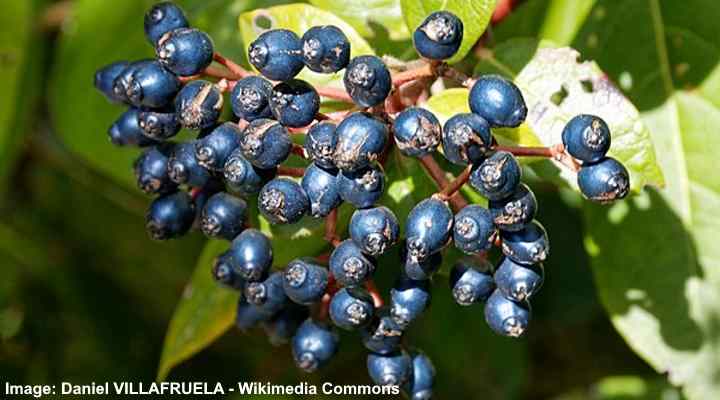
Laurustinus is a versatile evergreen bushy shrub with abundant clusters of deep bluish-black metallic berries. The large shrub blooms mid-spring with white flower clusters measuring 4” (10 cm) across. These contrast nicely with the glossy, dark green, oblong leaves. This easy-care shrub grows up to 12 ft. (3.6 m) tall.

Laurustinus flowers and leaves
Laurustinus shrubs are excellent for adding structure and interest to borders, hedges, and foundation plantings. The drought-tolerant shrubs are easy to prune, making them good plants for hedgerows, foundation planting, or privacy screens. This shrub is also deer-resistant, making it ideal for screening gardens in rural areas.
- USDA Planting Zones: 8 to 10
- Sunlight: Full sun to partial shade
- Mature Size: 6 to 12 ft. (1.8 – 3.6 m) tall and 6 to 10 ft. (1.8 – 3 m) wide
Nannyberry (Viburnum lentago)
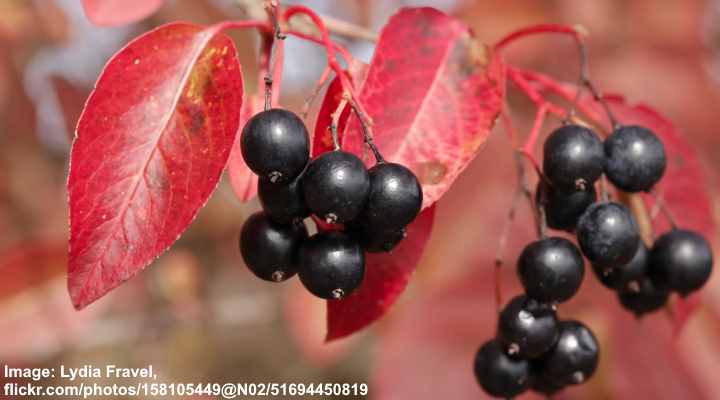
Nannyberry is a deciduous, multi-stemmed shrub with clusters of bluish-black berries dangling on red stalks. Eye-catching features of this viburnum variety are its abundant flat-topped clusters of white flowers, finely toothed ovate leaves, and showy dark fruits. Nannyberry has an upright, rounded form with high ornamental values for residential gardens.
Nannyberry grows around 20 ft. (6 m), making it ideal as a privacy hedge. Like most types of viburnum shrubs, this variety tolerates drought, heat, and urban conditions. Its tasty blackberries are delicious straight off the shrub or used to make jams, jellies, and pie fillings.
- USDA Planting Zones: 2 to 8
- Sunlight: Full sun to partial shade
- Mature Size: 10 to 20 ft. (3 – 6 m) tall and 6 to 12 ft. (1.8 – 3.6) wide
Oregon Grape (Mahonia aquifolium)

Oregon grape is a low-growing evergreen shrub with striking dark blue-purple to black berries with a waxy coating. This evergreen shrub is characterized by its holly-like leaves, clusters of golden-yellow flowers, and dark edible berries in late summer. Not growing taller than 6 feet (1.8 m), the shrub is popular in garden landscaping.

Oregon grape flowers and leaves
This spiny Oregon grape shrub is a great addition to a front or backyard as a foundation planting, ornamental shrub, or privacy hedge in shade gardens. Thanks to its deep burgundy fall foliage colors, fragrant yellow flowers, and masses of waxy dark bluish-black berries, it has year-round appeal.
The dark blue berries are not only attractive—they are tasty ingredients to make jams, jellies, and wine.
- USDA Planting Zones: 5 to 8
- Sunlight: Partial shade to full shade
- Mature Size: 3 to 6 ft. (0.9 – 1.8 m) tall and 2 to 5 ft. (0.6 – 1.5 m) wide
Common Lantana (Lantana camara)
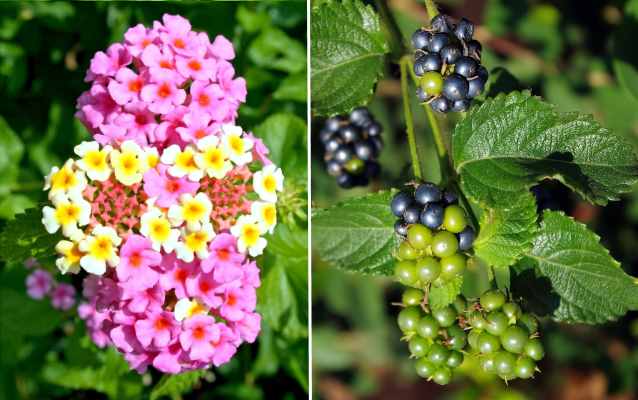
Common lantana flowers, fruit and leaves
Common lantana is a tropical evergreen shrub with stunning colorful flowers and showy dark-purple or black fruits. Suitable for USDA Growing Zones 10 and 11, the flowering shrub blooms throughout the year. Its tubular flowers are purple, yellow, pink, and orange shades. Lantana shrub bushy foliage consists of ovate leaves with toothed margins.
Lantana shrubs grow up to 6 ft. (1.8 m) tall. Their evergreen foliage and long blooming period make them popular for landscaping in warmer climates and sunny landscapes. The shrub’s vibrant flowers attract butterflies, bees, and hummingbirds. It’s a great addition to coastal gardens, borders, and foundation planting.
Also called bigleaf lantana or red sage, the ornamental shrub is rabbit and deer-resistant.
- USDA Planting Zones: 10 and 11
- Sunlight: Full sun
- Mature Size: 2 to 6 ft. (0.6 – 1.8 m) tall and up to 10 ft. (3 m) wide
Deadly Nightshade (Atropa belladonna)
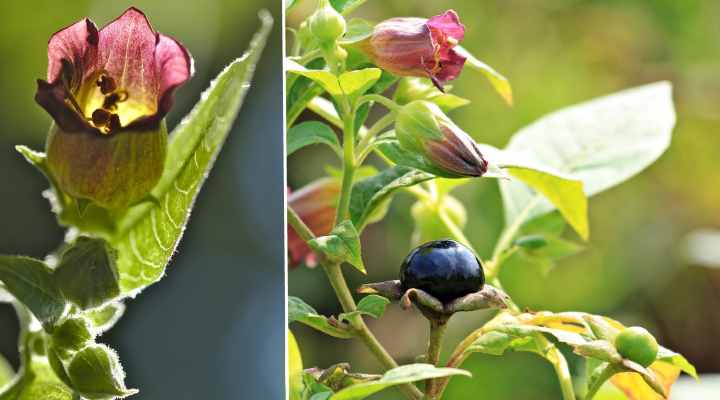
Deadly nightshade is a small, bushy perennial with highly toxic glossy, purple-black berries. This perennial herbaceous shrub is identified by its bell-shaped purple or reddish flowers, ovate leaves in a simple arrangement, and clusters of blackish fruits. Deadly nightshade usually grows 4 ft. (1.2 m) tall.
It’s vital to note that all parts of the plant—berries, leaves, stems, and roots—contain toxins. Consuming the berries can have serious, sometimes fatal consequences.
It’s vital to identify shrubs with black berries correctly to avoid poisoning. Deadly nightshade berries are similar to black nightshade (Solanum nigrum) fruits. Unlike black nightshade berries, fruits on belladonna shrubs grow singly and larger—about the size of small cherries.
- USDA Planting Zones: 5 to 9
- Sunlight: Full sun to partial shade
- Mature Size: 3 to 4 ft. (0.9 – 1.2 m) tall
Black Nightshade (Solanum nigrum)
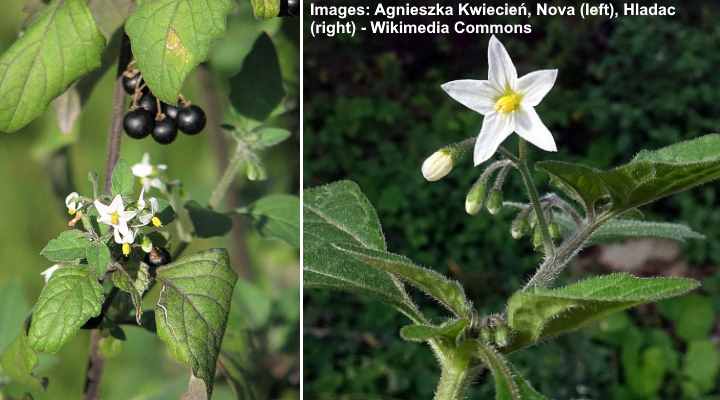
Black nightshade fruit, leaves and flowers
Black nightshade is a short-lived perennial shrub with black berry-like fruits in the summer and fall. The small pea-like fruits emerge green before ripening to dark purple or black and measure 0.25” (6 mm) in diameter. It has lanceolate leaves measuring 1.5” to 4” (4 – 10 cm) long and up to 3” (7.5 cm) wide, and tiny star-shaped white flowers with five petals
Black nightshade is adaptable to various conditions and can be found in fields, gardens, and waste areas. It is considered a weed in some regions due to its invasive nature. Its immature green berries are poisonous; however, its mature black berries are edible in small quantities. But consuming the berries is not recommended.
- USDA Planting Zones: 10 and 11
- Sunlight: Full sun
- Mature Size: 1 to 4 ft. (0.3 – 1.2 m) tall
Related articles:
